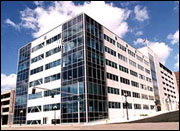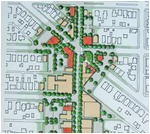 I’m going to start looking at some projects that were promised to bring revitalization to downtown Peoria and see how they turned out. Did they deliver what was promised? Today, we’re going to look at One Technology Plaza, on the corner of Adams and Fulton where the old Bergner store used to be.
I’m going to start looking at some projects that were promised to bring revitalization to downtown Peoria and see how they turned out. Did they deliver what was promised? Today, we’re going to look at One Technology Plaza, on the corner of Adams and Fulton where the old Bergner store used to be.
When that idea was first pitched in 1997, the Journal Star said the plan “to demolish the [Bergner] block and build an eight-story, $25 million career and technology center sounds precisely like the boost Peoria’s downtown needs,” adding the hopeful questions, “might this become a piece of an I-74 Technology Corridor?”
Many others sang the praises of the project, assuring us that this would be the catalyst to turn downtown around and bring in new jobs and industry. Here’s a sampling:
The L-shaped building, with main entrances on both Northeast Adams and Fulton streets “will reinvent downtown,” said commission Chairman Jim Baldwin.
“It will fill in the retail gap” in the downtown area with 17,000 square feet of street-level store space, said city Riverfront Development Director Tom Tincher.
–Peoria Journal Star, March 8, 1997
“This can truly make Peoria different from any community our size” in the nation, Mayor Bud Grieves said moments after the council voted 7-1 to accept a redevelopment agreement for the project with Prudential Cullinan Ltd….
At-large Councilman Charles Grayeb [said] that the tech center “embodies one of the most aggressive, visionary, public-private partnerships ever envisioned by our city. It will put Peoria in the (technology) development forefront and produce tax dollars quickly” through the jobs and industries it will attract, he said….
Its top floor will house both major and smaller technology-based firms that Cullinan expects to lure here. Its first floor will contain 17,000 square feet of retail space.
–Peoria Journal Star, July 2, 1997
One Technology Plaza opened in September 1999. Construction was paid for with the help of $9.6 million in general obligation bonds from the city. So now that it’s eight and a half years later, how have they filled the “retail gap” downtown? What new “major and smaller technology-based firms” have been lured here?
I took a walk downtown recently to find out. The retail establishments on the ground level are: Robert Morris College Bookstore, Jimmy John’s Sandwiches, Heartland Bank, Chase Property Management, and several empty storefronts, including the recently vacated Camille’s Sidewalk Cafe.
According to the directory in the lobby off of Fulton street, the businesses in One Technology Plaza are:
- Caterpillar (several divisions, including Global Deployment Services, Remanufacturing Division, Cat University CTT, and World Trading Corp.)
- Robert Morris College
- Workforce Network (City of Peoria Workforce Development Department and Central Illinois Workforce Board)
- U. S. Attorney’s Office
- Howard & Howard Attorneys offices
- Cullinan Properties
- OSF Organizational Development
- Federal Bureau of Investigation
Several of these are the original tenants. The Regional Office of Education used to be in One Technology Plaza, but moved to the Peoria County Courthouse. The building’s offices and retail stores are open 9-5 on weekdays, and aren’t open on Saturdays or Sundays at all. It would be interesting to see how much One Technology Plaza is contributing in tax revenue to the Downtown Business District TIF.
As I look over the list of tenants, I don’t see any retail gap being filled. How many people, when they want to grab a quick Jimmy John’s lunch, think about going to One Technology Plaza, especially considering there are three other locations in Peoria that are probably more convenient? The problem is that there’s no nearby residential component to drive retail development. Any retail that locates here only caters to people who work downtown and can patronize a place during lunch. Or they have to try to draw people downtown with something really unique. Nothing unique here at One Technology Plaza.
And I certainly don’t see any new high-tech companies that have located in Peoria as a result of this multi-million dollar investment by the City. Caterpillar already has its world headquarters downtown, which is a huge asset, of course. But the promise was that new companies, large and small, would be “lured” here. Hasn’t happened. I see a lot of empty space in a soulless building.
This Downtown Promise: Unfulfilled.

 I’m going to start looking at some projects that were promised to bring revitalization to downtown Peoria and see how they turned out. Did they deliver what was promised? Today, we’re going to look at One Technology Plaza, on the corner of Adams and Fulton where the old Bergner store used to be.
I’m going to start looking at some projects that were promised to bring revitalization to downtown Peoria and see how they turned out. Did they deliver what was promised? Today, we’re going to look at One Technology Plaza, on the corner of Adams and Fulton where the old Bergner store used to be. A little over a week ago, the
A little over a week ago, the  Note to District 150 parents: The next time you feel compelled to express your concerns to District 150 board members, just go find a brick wall somewhere and talk to it. There are a number of benefits: you can hit it and not get arrested, you can do it any time instead of just 6:30 every other Monday, and the most important thing of all — you’ll get the exact same results.
Note to District 150 parents: The next time you feel compelled to express your concerns to District 150 board members, just go find a brick wall somewhere and talk to it. There are a number of benefits: you can hit it and not get arrested, you can do it any time instead of just 6:30 every other Monday, and the most important thing of all — you’ll get the exact same results.